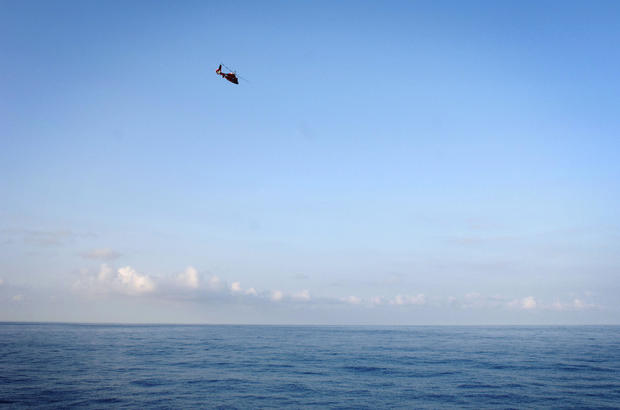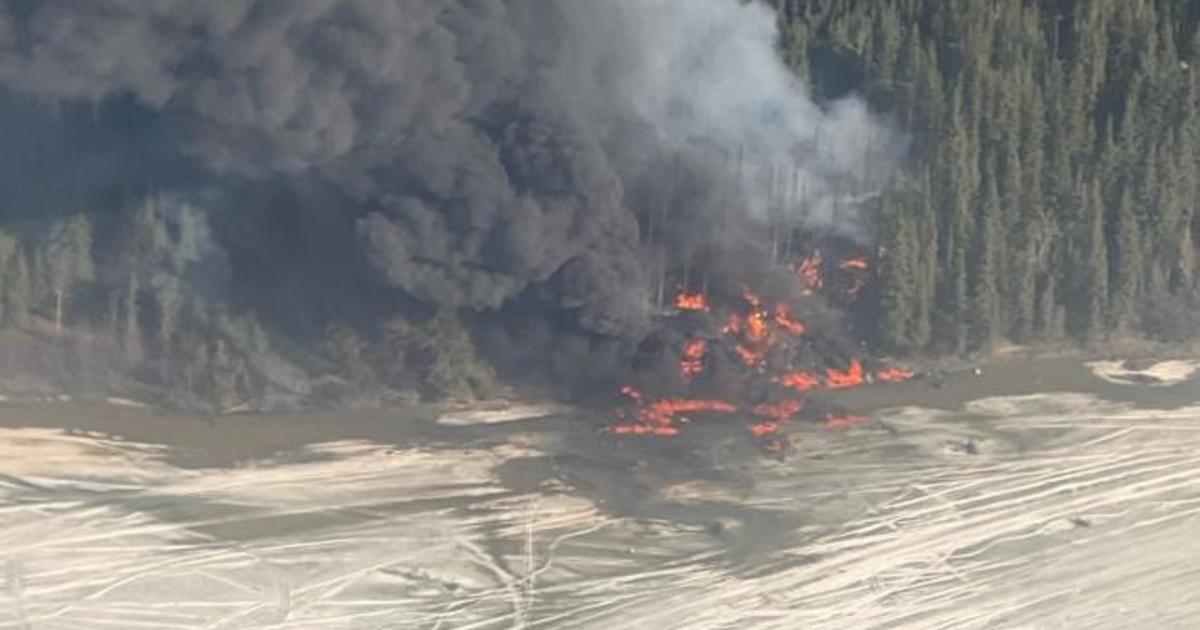Boat with two dozen U.S.-bound Haitian migrants disappears at sea: "People are going missing and no one is paying attention"
They were told to dress totally in black and to leave cellphones and all identifying documents, including passports, behind.
The group of about two dozen Haitians, maybe more, departed on a small motor boat from the coast of the Dominican Republic headed to Puerto Rico, about 80 miles away across the treacherous Mona Passage.
That was in early March. And that's the last anyone heard of them.
Their disappearance remains a mystery and a source of anguish for relatives, who refuse to accept that a boat full of people could just vanish. The agencies that routinely patrol the area - the U.S. Coast Guard, U.S. Customs and Border Protection and the Dominican Navy - say they have no record of a boat fitting that description capsizing in the passage.
"People are going missing and no one is paying attention," said Mozeline Beauvais, 48, a nurse from Philadelphia whose 20-year-old foster daughter, Fedena Louis Jeune, is among the missing. "They're young girls. They're young boys, people in their 20s. They are moms with babies."
The missing people are among the thousands of Haitians who have been desperately taking to the sea in the past few months, fleeing the desperation in their homeland in the largest exodus of Haitians since 2004. Though most leave from the northwestern Haitian coast bound for the Florida Keys, many others journey through the neighboring Dominican Republic, where they pay smugglers to get them on boats to Puerto Rico. Since October alone, the U.S. Coast Guard has intercepted more than 5,300 Haitians at sea.
No one knows how many have tried to make the trip and never made it. The only certainty, U.S. authorities say, is that the voyages are frequently deadly.
Beauvais says she last spoke to her daughter on Feb. 27. Louis Jeune gave no indication of her plans to take a dangerous sea voyage to the United States. Beauvais says she found out about the trip after friends of her daughter's called and said they had not heard from her. After asking questions, Beauvais said she learned that her daughter, whom she had cared for from infancy, and a friend had boarded a boat bound for Puerto Rico.
After digging around, Beauvais found out a little more: Her daughter had taken one of the small, makeshift open boats known as yolas that smugglers use to take migrants from the Dominican Republic to Puerto Rico through the Mona Passage.
Beauvais has spent months contacting what is now a three-page-long list of agencies and immigration detention facilities around the U.S. trying to find out if any of them has her daughter in custody.
"My head spins because I don't know what I am supposed to do," she said. "I just want to focus on finding her."
Other relatives of the missing, desperate for information, have come together in a group on the WhatsApp social media platform, where they have shared photos and compiled a list of the passengers. Among them: Rosedarline Aulistin; Fedena Saint Germain; Dort Mikerlange, and 36-year-old Daphnee Benoit and her six-year-old son, Jovendjy.
Through text messages and anonymous voice notes they've tried to drill down: From where and when exactly did the boat depart? How much did passengers pay? Who was on the trip? And most important: How could a boatload of Haitians disappear without a trace?
Through their pain, they have also provided portraits of some of the missing. There is the "pretty, young lady who is well-educated," whose uncle in Canada said he thought she was being smuggled on a cruise ship when his sister told him about the voyage; a man who sold his car to find the money to pay for the trip; and Mirielle Lamy, a singer whose YouTube channel now features a purple banner with her face illuminated by golden light.
"I cannot sleep. Every time I close my eyes I see my sister," said Naomie Lamy, who lives in Miami and is searching for Mireille, her younger sister, a singer known as "Miyou."
Family members interviewed by the Miami Herald say they have checked with authorities in Puerto Rico and the Dominican Republic for information about the missing boaters. So far they have come up empty. One relative told the Herald that the migrants were told to wear all black and leave all documents behind, an account that was also separately mentioned by one of the people in the WhatsApp group.
Leonel Charles, a Haitian lawyer in the Dominican Republic, said he was contacted by the sister of one of the missing to look into the disappearance. He hired an investigator to track down the organizers of the voyage, but said they never found them. "We never found anything concrete," he said.
Charles said he was told by the family that the boat left from an area of the country near Punta Cana, the Dominican Republic's easternmost tip. Other family members believe the boat may have left from La Romana in the southeast.
The U.S. Coast Guard in Puerto Rico, U.S. Customs and Border Protection in Puerto Rico and U.S. Immigration and Customs Enforcement told the Herald they had no records on a missing migrant boat fitting the description provided by reporters, or information about a capsizing in early March. The Dominican Navy also said it had no record of a boat or passengers matching the descriptions.
"We are not aware that that was a case that was reported to the Coast Guard or that there was a response from the Coast Guard," said Ricardo Castrodad, the Coast Guard spokesman in San Juan.
Jeffrey Quiñones, a U.S. Customs and Border Protection spokesman, said his agency has no record of interceptions or people washing up on shore in Puerto Rico during the time period matching the passenger count, or any details of the missing boat.
U.S. authorities emphasized that each and every illegal boat that crosses the Mona Passage risks capsizing. Yolas are poorly constructed, often by smuggling operators in underground, makeshift shipyards in remote locations. Engines are unreliable. The weather and ocean conditions can change in the blink of an eye. Sharks, which are known to have killed migrants in the Mona Passage, lurk below the surface. Life jackets on board are a rare occurrence.
It's "a mass rescue waiting to happen," said Castrodad. "Each of these trips represents an incredible risk for all the people who are on the trip… and for the people responding because for people trying to rescue that amount of people in adverse maritime conditions is a very risky operation. Time is critical, and anything can happen."
Castrodad says it's possible for a boat to capsize or get in trouble without the Coast Guard or other authorities finding out. Often, news that something has gone wrong comes from family members calling the agency about relatives who went on these journeys, or from migrants themselves asking to be rescued.
It doesn't take much for the often overloaded yolas to sink in the channel's unstable currents. Last month a boat capsized in the passage near Puerto Rico. Eleven women, all Haitian, were confirmed dead, while 38 others were rescued. Authorities believe more are still missing based on what survivors said.
It was one of at least three capsizing incidents in the Mona Passage that authorities responded to in May.
People frequently die or disappear without a trace on the passage "due to the extreme environmental conditions... and because the boats used are handmade and are not equipped to make crossings at sea," said Edwin Viales, who works with the United Nations' International Organization for Migration.
Viales is the regional monitor of the Missing Migrants Project for the Americas. Since 2014, the agency has been collecting information about migrants who die in the process of traveling toward an international destination, regardless of their legal status. It has recorded 6,265 missing in the Americas, while noting that the figure is an undercount, given the challenges.
The Caribbean area has the second highest number of deaths and disappearances in the region after the U.S.-Mexico border, Viales noted. Last year 65 people died or went missing in the shark-infested passage last year, and as of February of this year the figure was already at 71, according to the Missing Migrants Project.
Viales said most of the people who lose their lives on the Mona Passage route are Haitian, Dominican, Cuban or Venezuelan. But he said there is a huge under-reporting of data in the Americas region because of what has become known as "invisible shipwrecks" - migrants who die at sea whose deaths are never officially recorded.
Guerline Jozef, co-founder of the Haitian Bridge Alliance, which works with Haitian migrants, fears that as the situation grows more desperate in Haiti and more Haitians make the dangerous journeys, whether overland from South America to the U.S.-Mexico border or at sea, more people will die.
Like the family members, she too has questions: "Is human trafficking involved? Did they ever make it to the boat? Did the boat ever leave shore?"
"We don't know," Jozef said. "Until the person reaches the United States and either gets detained or deported, you don't know the countless lives that have been lost, just disappeared never to have been heard from again."
Lamy, who believes her sister Mirielle could have traveled with another artist, said the singer moved to the Dominican Republic from Port-au-Prince last year fleeing the shootings and kidnappings in the Haitian capital, where violent gang clashes have forced the displacement of tens of thousands.
Mirielle had rented a home and was working in transportation, Lamy said. She posted videos of herself singing on YouTube, where she had amassed almost 2,800 followers.
On the early morning of March 2, Mirielle called Lamy. Between 7 a.m. and 11 a.m, she also sent her several voice notes. In one, she told her sister that she needed to talk to her. In another, she texted an address and asked her to send money to a woman. But in another voice message, Mirielle reversed course, telling her sister not to send the money, that she was leaving on a boat at 2 p.m.
Lamy and a nephew who lives in Haiti said they had no idea that Mirielle had any plans to go on an illegal voyage across the Mona Passage.
"Knowing my aunt, she doesn't like going to the water, she doesn't even like going to the pool," said Josué Lamy, who was making preparations to head to the Dominican Republic to retrace his aunt's final steps. Last time the family visited the southeast Haitian port city of Jacmel, he said, "we went to the beach, and she didn't even want to go in the water. That's what's so crazy about this to us."
Naomie Lamy traveled to the Dominican Republic in search of her younger sister in May, but had no luck. A 15-minute YouTube video pays homage to the singer, saying, "It's with a lot of sadness that we announce the disappearance of Mirielle Lamy."
While some family members of the missing still hold out hope, others fear the worst. Some on the WhatsApp group have even suggested that the reason for the black clothing was to deliberately sacrifice the group on the high seas as part of a dark magic sacrifice.
The voice notes in Creole on the app group have gone from pleas for answers and an exchange of information to anger, threats and suspicion of group members about each other, and accusations that some of them have connections to the traffickers.
In recent days, some people in the chat have begun to attack someone identified only as "Jimmy." In anonymous voice notes, they accuse him of lying and knowing what happened to their loved ones. While some threaten bodily harm, others have promised to call law enforcement.
They accuse Jimmy of refusing to answer their phone calls and lying to them about the whereabouts of their loved ones. Some in the group say Jimmy has told them their family members are being detained in Puerto Rico without access to phones.
But that is not true, said a man who did not give his name in a voice note. His niece, he said, was on the boat, and he warned that he had already contacted Dominican authorities about Jimmy. Now living in Canada, the man described his own experience after he came to Miami from Haiti in 2007 and was locked up in the Krome Detention Center in Southwest Miami-Dade, where he says he was given access to a phone. Others, have said, they have reached out to Dominican officials and even vow to go in search of Jimmy.
"What did Jimmy do with the people?" said Doinois Emile, whose 26-year-old daughter Daphnee is among the missing. "You can't keep people in all of this suffering. I just want to hear her voice one last time."
Emile, who lives in Indiana, said he believes the people in the group are still alive and being hidden somewhere; he refuses to believe that his daughter, who knew how to swim, and the rest could go missing with no trace.
"Where are the people? I don't believe that a boat can just sink and you have no evidence. The mariners on the waters would come across the people," he said. "All of them could have died and you mean to tell me and not one body would have come up to the surface?"
Emile says he relocated Daphnee and a younger sister to the Dominican Republic from Haiti several years ago so they would not become victims of their homeland's raging gang violence and kidnappings. Several months ago Daphnee, who was impatient about joining her father in the U.S., called. She needed money, she said, to pay for a voyage. Reluctantly, Emile, who works at a car dealership, wired $5,000 in cash.
"If I didn't send this money she would have hated me," he said.
The trip did not happen immediately. One of the passengers, who had traveled from Haiti to make the boat trip, spent four months living with Emile's daughters and her 6-year-old waiting for the boat to depart.
"She became like a mother for them inside the house," said Emile, who spoke with the young mother on several occasions.
The day the women left, Emile said his younger daughter was home and saw "when the bus came to pick them up."
Emile says if there were evidence his daughter had perished at sea, he could accept that she was dead. He could also accept that she is imprisoned in a U.S. detention center.
"The pain would be one hit," he said. But waking up each day not knowing is too much, he said, breaking into tears.
"They took my child and I don't know what they did with my child. I don't know where she is," he said. "I just want to hear her voice one last time."




